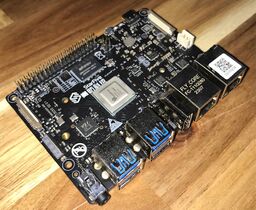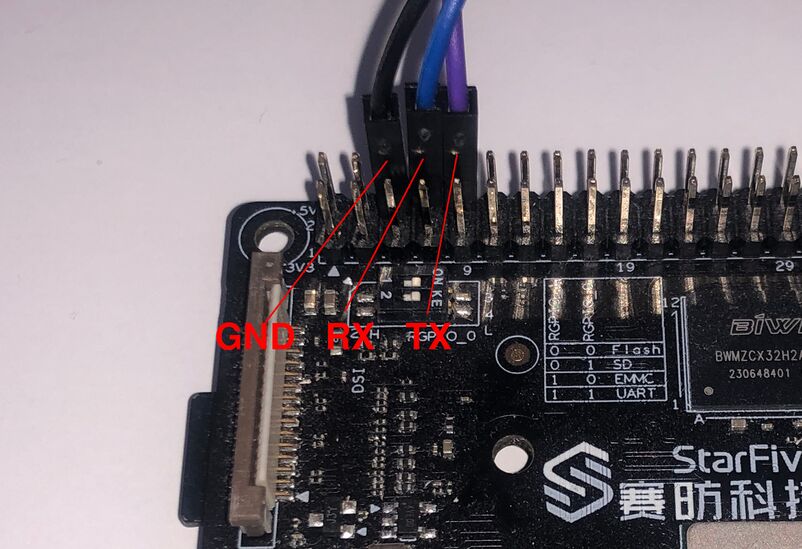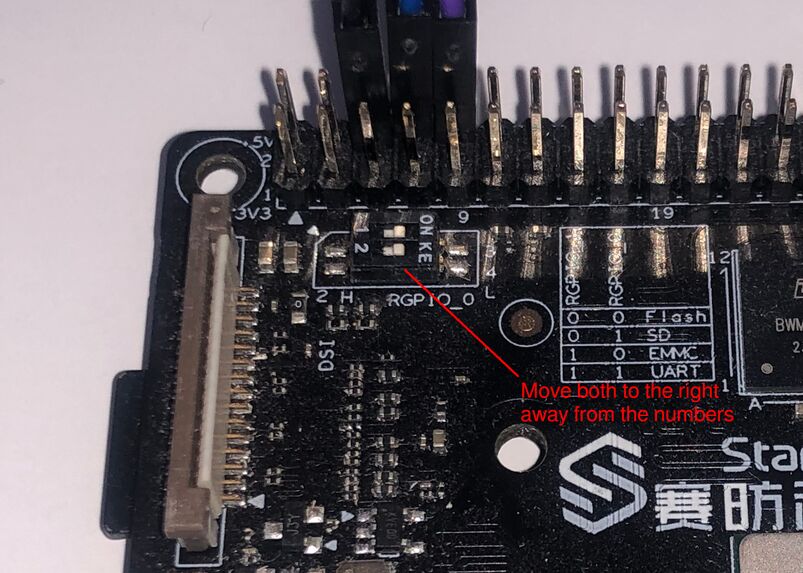NixOS on RISCV/VisionFive 2
| VisionFive 2 | |
|---|---|

| |
| Manufacturer | StarFive |
| Architecture | RISC-V |
| Bootloader | Custom or UEFI |
| Boot order | Configurable; SD, USB, Netboot |
| Maintainer | onny |
| VisionFive 2 | |
| SoC | JH7110 |
The VisionFive 2 is a single board computer (SBC) that uses a RISC-V processor with an integrated GPU. It supports Linux operating system and various multimedia features, such as 4K video decoding and OpenGL ES 3.212.
Status
See https://rvspace.org/en/project/JH7110_Upstream_Plan for an overview of which features are already supported by the latest mainline kernel used by NixOS.
Please note that HDMI display patches haven't been merged yet.
There's also a port of the UEFI reference implementation EDK2 available at https://github.com/starfive-tech/edk2 to support a future generic RISCV Linux image that can be booted from any RISCV device.
Setup
Precompiled SD-card images can be found on the Hydra instance my NickCao. Before flashing the image, use unzstd to unpack the downloaded archive.
Manually build a SD-card image
First create this Flake file
{
inputs.nixpkgs.url = "github:nixos/nixpkgs/nixos-24.05";
inputs.nixos-hardware.url = "github:nixos/nixos-hardware";
# Some dependencies of this flake are not yet available on non linux systems
inputs.systems.url = "github:nix-systems/x86_64-linux";
inputs.flake-utils.url = "github:numtide/flake-utils";
inputs.flake-utils.inputs.systems.follows = "systems";
outputs = { self, nixpkgs, nixos-hardware, flake-utils, ... }:
flake-utils.lib.eachDefaultSystem (system:
rec {
packages.default = packages.sd-image;
packages.sd-image = (import "${nixpkgs}/nixos" {
configuration =
{ config, ... }: {
imports = [
"${nixos-hardware}/starfive/visionfive/v2/sd-image-installer.nix"
];
# If you want to use ssh set a password
users.users.nixos.password = "test123";
# OR add your public ssh key
# users.users.nixos.openssh.authorizedKeys.keys = [ "ssh-rsa ..." ];
# AND configure networking
networking.interfaces.end0.useDHCP = true;
networking.interfaces.end1.useDHCP = true;
# Additional configuration goes here
sdImage.compressImage = false;
nixpkgs.crossSystem = {
config = "riscv64-unknown-linux-gnu";
system = "riscv64-linux";
};
system.stateVersion = "24.05";
};
inherit system;
}).config.system.build.sdImage;
});
}
Run following command to build the SD-card image
nix build .#
Flashing the SD-card image
After successfull build or unpack, flash the resulting file (build file is in the directory results/sd-image) to the target device, in this example the SD-card (/dev/mmcblk*). Note that everything on the target device gets erased.
dd if=result/sd-image/nixos-sd-image-23.11pre-git-riscv64-linux-starfive-visionfive2.img of=/dev/mmcblk0 status=progress
Usage
The board has "boot mode pins", from which we can control what device should be booted from.
See official documentation https://doc-en.rvspace.org/VisionFive2/Quick_Start_Guide/VisionFive2_SDK_QSG/boot_mode_settings.html .
First enable booting from SD-card by setting jumper 1 and 2 to "FLASH/QSPI mode" (both QSPI and SDIO mode support booting from an SD card):
For UART access, wire GND (black), RX (blue) and TX (purple) to your adapter

Update board firmware
sudo visionfive2-firmware-update-flash
Bootstrap NixOS system configuration at /etc/nixos/configuration.nix
nixos-generate-config
Tips and tricks
Using the Visionfive 2 as a remote builder to build native RISCV packages for e.g. the Visionfive 2
Building an NixOS system image that can be flashed to an SD card or NVMe SSD requires to build RISCV binaries, more specifically for the "riscv64-linux"platform. From a typical Intel/AMD computer we can either
- emulated native compile using QEMU virtualization by enabling the binfmt kernel feature on NixOS configuration setting
boot.binfmt.emulatedSystems = [ "riscv64-linux" ];). This can be fast if everything is downloaded pre-compiled from the cache.nixos.org cache (not supported yet though) and only few packages really need local compilation. In reality it can be extremely slow, e.g. compiling a Linux kernel alone can take days. - cross-compile to RISCV from another (e.g. "x86_64-linux) machine using the setup in the example above. However very few packages will be cached from cache.nixos.org as cross-compiled packages are less likely to be pre-build than native compiled. So the compile itself is fast but there will be a lot more to compile locally. In practice this can be quite fragile, because you may encounter packages that don't really support cross-compilation get stuck.
- native compile on an remote builder like the Visionfive 2 itself running its custom Debian Linux at the beginning or later NixOS. This is quite simple to setup and reasonably fast as most packages can be pre-build and cached on cache.nixos.org, and building a remaining Linux kernel only takes 3h on the Visionfive 2.
Setting up the Visionfive 2 as a remote native builder can be done following the steps at https://wiki.nixos.org/wiki/Distributed_build. The rough steps are as follows:
- Install the Nix package manager on Visionfive 2 Debian OS the normal, multi-user way with
sh <(curl -L https://nixos.org/nix/install) --daemon. If you already have NixOS running on the Visionfive 2, then you can skip this step. - Setup a
sshconnection from your local machine to the Visionfive 2, especially addingSetEnv PATH=/nix/var/nix/profiles/default/bin:/usr/local/sbin:/usr/local/bin:/usr/sbin:/usr/bin:/sbin:/binto the Pi's/etc/ssh/sshd_configfile. If you already have NixOS running on the Visionfive 2, then you can skip this step. - Make the remote Visionfive 2 known to you local computer by adding it as a
nix.buildMachinesentry to your/etc/nix/configuration.nixfile and use connection protocolssh-ng(!). - You can then build, e.g. an NixOS sd card image with a call similar to
nix build .\#nixosConfigurations.visionfive2.config.system.build.sdImage - flash that resulting image onto an SD card or NVMe SSD using a call similar to
zstdcat result/sd-image/nixos-sd-image-23.11.20230703.ea4c80b-riscv64-linux.img.zst | sudo dd of=/dev/mmcblk0 bs=100M status=progressand place that card into the Visionfive 2.
Deploy and Update the Visionfive 2 NixOS system once it's running NixOS
Once the Pi 5 is running NixOS, you can update it with newer NixOS system configurations using e.g. the usual nix-rebuild
tool with a call similar to
nixos-rebuild --flake .#visionfive2 --build-host piuser@visionfive2 --target-host piuser@visionfive2 --use-remote-sudo switch
that uses the SSH connection from the remote builder section.
See this guide for a good explanation of this terminal call.

